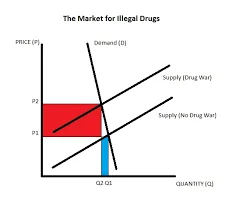When analyzing a case involving marijuana legalization becomes the epicenter of the discussion, it is imperative to understand that approximating all the economic costs is never a walk in the park. An analysis of several expenses is essential. The state of Ohio is the focus since it loses out a lot of cash when supporting those convicted of crimes. The conviction for a crime related to a felony imposes severe penalties on the state. Those earning felonies get well-paying jobs in the region more than anyone else. One challenge that is still present is getting apartments. The outcome hurts the economy significantly. The existence of a class that cannot use its expertise to ensure productivity in Ohio is a negative step and should be thwarted by all means. One approach to be considered is legalizing marijuana in Ohio. The long-term benefits of such an approach will contribute to the growth of the economy. However, it is still an uphill task quantifying the initial advantage.
Benefits of legalizing marijuana
The first benefit of the legalization is the tax receipts that will arise due to the trade. According to the activities related to the product in Washington and Colorado, a tax is imposed, dramatically adding to the GDP. The 25 percent tax levied on sales in Washington is key in fostering economic growth and development in the region. The approach also applies in Colorado, which employs a 10-percent tax on the product. Even though enough statistics exist to prove the amount of money raised due to the tax levied in the states, it is speculated that Washington managed to raise close to $500 million from the trade in 2014 (Vitiello, 2016). The figures for Colorado are also within that range. The two states continue to divert such revenue into activities that benefit the nation. The same case will apply due to legalization in Ohio. According to the two states, the individual municipalities can set tax rates. The cities have the ability to set higher tax rates based on their demands. The outcome is indeed a boom for communities in the region.
Ideally, looking for marijuana legalization through the tax receipt is a myopic approach. There is a need to have a comprehensive understanding of such an instance. The costs related to criminal justice are another dimension of the same. America stands out as one of the countries with figures on matters related to policing, jails, and court processes. The ability to incarcerate more than a million individuals in the region is worth noting regarding the legalization process. It is not necessary that everyone in such jails in the area are as a result of the marijuana trade (Vitiello, 2016). However, a significant number are jailed due to the marijuana trade. Harvard University conducted research that made it known that states are likely to save close to $5.3 million annually once they legalize marijuana. The approach acts as an aggregate total when analyzing the case of the legalization of marijuana in Ohio. The move is worthy, and the government should not hesitate to step in Ohio.
Ultimately, a consideration of the public defense costs makes the legalization of marijuana in Ohio worthy. Imagine the amount of money the state uses when providing an attorney based on the Sixth Amendment to every constitution. It is indeed high and legalizing marijuana will cut such costs. The ability to legalize marijuana will reduce the number of people of lawyers among low-level offenders. Ohio should take such an initiative and divert the finances to protect people who have committed severe offenses. The approach might not relate directly to the economic benefits but will still initiate a scenario in which fewer incentives will be provided to lawyers to help clients plead on marijuana-related charges. The outcome remains a fair criminal justice system.
Market Structure
An oligopoly market structure should be applicable in this case. There needs to be a limit on the number of growers and product sellers. That will help in setting the best prices for the product. Moreover, it will be possible to address other moral obligations that result from the trade. Having an open market, for instance, is detrimental since the use of the product will be broad (Vitiello, 2016). That might present some mental impact on the population. That might later force the government to invest much money in psychological disorder facilities. In any given implementation, there is a need to understand all the related aspects to avoid creating a dilemma that might result in a further waste of resources.
Accounting for potential negative externalities
Legalizing marijuana means that users will increase. Moreover, the market will shift differently since the focus will be on scalability. Ideally, such an approach might negatively impact specific groups in society (Caulkins & Kilmer, 2016). However, having a high marketing tax will offer a certain level of restriction. Few stakeholders will be able to market the product. Sometimes, marketing is unlikely to see the light of the day due to the imposed taxes. At the same time, the benefits outlined above will thrive. The state will manage to benefit from such an implementation.
Change of market after de-criminalization
Currently, the use of marijuana in the region is illegal, and its use can’t be specified. However, after it is made legal, the oligopoly markets will still control its use. The market prices will be high due to the taxes imposed (Vitiello, 2016). There is the possibility of a drop in demand due to the high prices. In every market, high taxes must add to the costs, and that will reduce the demand. The country will benefit due to this since it will manage to get revenue and still cut on consumption. The high rate of consumption relates to the mental disorders that have grown in the region for the past decade. Such a reduction will be a significant step in reclaiming great Ohio. In any case, it is the role of the authority to understand the market forces and pass laws that will improve the welfare of the society.
In conclusion, Ohio should take the step to legalize marijuana due to the tremendous benefits presented in the essay. Apart from the tax levies, the state will manage to save a lot on court-related processes. Other states, such as Washington and Colorado, already enjoy the benefits, and Ohio should follow suit. It is the role of authorities in every nation to initiate some streams of improvements. An understanding of economics depicts that tax addition alone is not enough and the state should bank on other processes that will also cut costs. Such an approach will foster growth as well as productivity among the population. The benefits of the legalization will most benefit the municipalities. The extra income will help in the development of schools as well as community-based programs. Enforcement centers will also suffer less due to such legalization. There will be few instances of arrests, and that will save the state tremendously. Due to the legalization, Ohio will take a step forward. The success will only be compared with critical states in the region, such as Washington and Colorado.
References
Caulkins, J. P., & Kilmer, B. (2016). Considering marijuana legalization carefully: insights for other jurisdictions from analysis for Vermont. Addiction, 111(12), 2082-2089.
Vitiello, M. (2016). Legalizing Marijuana and Abating Environmental Harm: An Overblown Promise. UCDL Rev., 50, 773.
Cite This Work
To export a reference to this article please select a referencing stye below:










